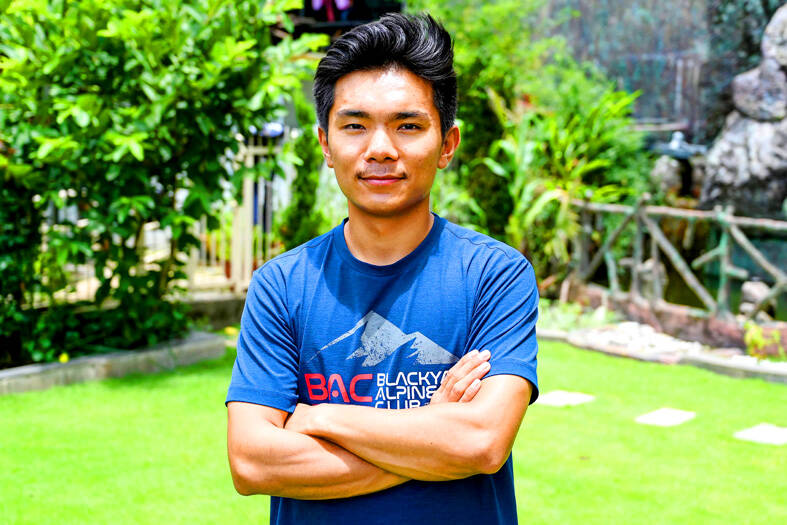At just 18 years old, Nepalese mountaineer Nima Rinji Sherpa is on the brink of a remarkable achievement. With 13 of the world’s highest peaks already behind him, he is now one summit away from becoming the youngest person to conquer all 14 mountains towering above 8,000m.
Sherpa, who already holds multiple records from his ascents of dozens of peaks, said he is on a mission to “inspire a new generation and redefine mountaineering.”
His final challenge, Shishapangma in Tibet, awaits him next month — if China issues a permit.

Photo: AFP
Summiting all 14 “eight-thousanders” is considered the epitome of mountaineering aspirations.
Italian climber Reinhold Messner first completed the feat in 1986 and only about 40 climbers have successfully followed in his footsteps. Many other elite climbers have died in the pursuit. All of the mountains are in the Himalayas and neighboring Karakoram range, which span Nepal, China, India and Pakistan.
Reaching each summit requires entering the thin air of the “death zone,” where there is not enough oxygen to sustain life for long.

Photo: AFP / 14 Peaks Expedition
“When I am in the mountains, I may die anytime,” Sherpa said. “You need to realize how important your life is.”
The young man says the mountains have taught him to stay calm.
“Mentally, I have convinced myself ... when I see an avalanche, bad weather, an accident in the mountains, I am not in a hurry, I don’t get nervous,” he said. “I have convinced myself; this is normal in the mountains. I think this has helped me a lot.”
Hailing from the Sherpa ethnic group, renowned for its mountaineering prowess, the teenage climber is no stranger to the treacherous terrain.
His uncle, Mingma Gyabu “David” Sherpa, holds the record of the youngest person to climb all 14 peaks. He achieved it in 2019 at the age of 30.
Nima Rinji Sherpa’s father, Tashi Sherpa, grew up in the remote Sankhuwasabha district, herding yaks before joining mountaineering as a teenager with his siblings.
The entrepreneurial brothers now lead the biggest mountain expedition company in Nepal, Seven Summit Treks, and its sister company, 14 Peaks Expedition.
“I come from a privileged family, but going to the mountains has taught me what hardship is and the real value of life,” the teen climber said.
Raised in the bustling capital, Kathmandu, Nima Rinji Sherpa initially preferred to play soccer.
He was also more interested in filming and photography than following his father’s footsteps.
“My whole family is from mountaineering. I have always been near mountaineering and expeditions, but I never wanted to be myself in mountaineering,” he said.
Instead, he would take his camera out to the mountains during school holidays.
However, two years ago, he put his camera down to pursue mountaineering and has since broken records.
In August 2022, Nima Rinji Sherpa scaled his first of the 14 peaks, reaching the top of the world’s eighth-highest Mount Manaslu (8,163m) at the age of 16, the first teenager to do so.
The last mountain he scaled was Kanchenjunga in June, again making a record for the youngest to climb the world’s third-highest mountain.
“I have learned so many things about nature, the human body, human psychology”, he said. “Everything in the world I learnt from the mountain.”
When not in the mountains, the student runs on the treadmill every day and avoids junk food.
“Physically and mentally, you should be very fit for big mountain climbing,” Tashi Sherpa said, adding that he had been helping his son prepare for the challenge for years.
“He will inspire newcomers,” he added.
Nepalese guides — usually ethnic Sherpas from the valleys around Everest — are considered the backbone of the climbing industry in the Himalayas.
They carry the majority of equipment and food, fix ropes and repair ladders.
Long in the shadows of their paying foreign customers — it costs more than US$45,000 to climb Everest — Nepalese mountaineers are slowly being recognized in their own right.
The teenager envisions a future where climbing is recognized as a demanding, athletic pursuit for Nepalese climbers as well.
“My focus will be to make mountaineering a professional sport,” he said.
His hero is Tenzing Norgay Sherpa, who climbed Everest, the world’s highest mountain, along with New Zealander Edmund Hillary in the first party to successfully do so.
Nima Rinji Sherpa considers his idol as big to climbing as Lionel Messi or Cristiano Ronaldo are to soccer.
“Norgay is someone who is in that league,” he said.

Shohei Ohtani and Clayton Kershaw on Friday joined their Los Angeles Dodgers teammates in sticking their fists out to show off their glittering World Series rings at a ceremony. “There’s just a lot of excitement, probably more than I can ever recall with the Dodger fan base and our players,” manager Dave Roberts said before Los Angeles rallied to beat the Detroit Tigers 8-5 in 10 innings. “What a way to cap off the first two days of celebrations,” Roberts said afterward. “By far the best opening week I’ve ever experienced. I just couldn’t have scripted it any better.” A choir in the

After fleeing Sudan when civil war erupted, Al-Hilal captain Mohamed Abdelrahman and his teammates have defied the odds to reach the CAF Champions League quarter-finals. They are today to face title-holders Al-Ahly of Egypt in Cairo, with the return match in the Mauritanian capital, Nouakchott, on Tuesday next week. Al-Hilal and biggest domestic rivals Al-Merrikh relocated to Mauritania after a power struggle broke out in April 2023 between the Sudanese army and a paramilitary force. The civil war has claimed tens of thousands of lives and displaced more than 12 million people, according to the UN. The Democratic Republic of the Congo-born Al-Hilal

Shohei Ohtani, Teoscar Hernandez and Tommy Edman on Thursday smashed home runs to give the reigning World Series champions the Los Angeles Dodgers a 5-4 victory over Detroit on the MLB’s opening day in the US. The Dodgers, who won two season-opening games in Tokyo last week, raised their championship banner on a day when 28 clubs launched the season in the US. Dodgers manager Dave Roberts shuffled his batting lineup with all four leadoff hitters finally healthy as Ohtani was followed by Mookie Betts, then Hernandez and Freddie Freeman in the cleanup spot, switching places with Hernandez. “There’s a Teoscar tax to

Matvei Michkov did not score on Monday, but the Philadelphia rookie had a hand in both goals as hosts the Flyers earned a 2-1 victory over the Nashville Predators. Ryan Poehling and Jamie Drysdale got the goals for the Flyers (31-36-9, 71 points), who won their third straight. Michkov and Travis Konecny assisted on both. Ivan Fedotov stopped 28 shots to earn his first win since March 1, ending a personal six-game losing streak. Zachary L’Heureux got the lone goal for Nashville. Michael McCarron and Brady Skjei got the assists for the Predators (27-39-8, 62 points), who have just four goals in their